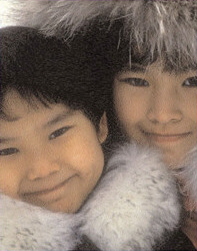March 11, 2008, - 10:16 am
PETA & The Global Warming Crowd v. The Eskimos
By Debbie Schlussel
Well, it’s not just PETA a/k/a PUTAh (People for the Unethical Treatment of Animals and humans). It’s the whole animal rights and global warming crowds in the U.S. and Canada. They’re all threatening the Eskimos of North America and their way of life, by trying to designate their food, clothing, etc.–polar bears–as an endangered species.
This is interesting to watch, since the animal rights crowd likes to think of itself and an ally of the “indigenous peoples” and a return to a “natural” life “of the earth.” In their zeal to protect animals, they’re actually opposing all of that. And it’s interesting to note that the polar bear population has actually increased exponentially, not decreased as all of the environmental horror films tell us. It’s also interesting because the story provides a nice contrast to the unrepresentative Eskimo mom whom Oprah presented to the world as a global warming zealot.:


Eskimos in Alaska and Canada have joined to stop polar bears from being designated as an endangered species, saying the move threatens their culture and livelihoods by relying on sketchy science for animals that are thriving.
Although they say sea ice has melted, some Natives question the accuracy of the most dire predictions of a warming climate in the Northern Hemisphere, and members of the Inuit Circumpolar Council seek evidence that a change would seriously harm the bears.
Their stance has put them at loggerheads with a usual ally: environmentalists who say the bears need protection now to survive a warmer climate in the future.
“It would have a really big effect on us Inuit, because we go by dog team to traditionally hunt polar bears,” said Jamie Kablutsiak, who guides U.S. trophy hunters for big money onto the ice on Canada’s Hudson Bay. As for the bears, “I don’t think they’re decreasing because there’s usually lots, even in summer time,” he said.
A decision by the U.S. Fish and Wildlife Service will come soon, spokesman Bruce Woods said.
The petition marks the first time a healthy species would be considered at risk under the Endangered Species Act and the first time global warming would be officially labeled a species’ main threat.
Polar bears have increased from a population of 5,000 in 1972 to between 20,000 and 25,000 today.
The Center for Biological Diversity submitted a petition in 2005 for endangered species protection based on projected habitat loss due to global warming.
The petition resulted in a 2007 report by the U.S. Geological Survey, which predicted a loss of two-thirds of the world’s polar bear population by 2050, based on a projected 42% summertime loss of “optimal polar bear habitat” such as shallow-water sea ice.
Some scientists, however, question predictions that sea ice will disappear, and even that polar bears would disappear if it did.
Richard Glenn, an Alaskan Inuit hunter and ice researcher, told U.S. senators in January that “marginal ice,” which freezes in winter and melts in summer, will grow as multiyear ice disappears.
“Even the Fish and Wildlife Service study acknowledges that ‚Ķ may be beneficial to ice seals and polar bears,” he said.
The aim of the environmentalists is to use the Endangered Species Act to force the U.S. government to take action on global warming, said Kassie Siegel, a lawyer for the Center for Biological Diversity. It would require federal agencies “to look at the cumulative effect of greenhouse gases on polar bears” and limit emissions by cars and power plants, Siegel said. . . .
To the Inuit, the polar bear has been a source of food, clothing and income for millennia, said Duane Smith, president of the Inuit Circumpolar Council in Canada, which represents Inuit across Canada.
The Inuit Circumpolar Council, which represents Native communities in Greenland, Canada, Alaska and Russia, wants Fish & Wildlife not to make a decision until Natives have a greater role, Chairwoman Patricia Cochran said. Any decision should be based on “sound science,” which includes traditional knowledge, Cochran said.
Big money is at stake. Sport hunters pay between $25,000 and $30,000 each to bag a polar bear. . . .
Willie Soon, an astrophysicist at the Harvard Smithsonian Center for Astrophysics, said far too few data were used to make predictions about both climate change and polar bear behavior and populations.
“We looked at historical studies. The first thing you notice is the whole climatic system undergoes huge fluctuation,” Soon said.
Over the possibly 200,000 years the polar bear has existed as a species, it has survived “very harsh conditions” of extreme cold, such as ice ages, and warmth, such as the last interglacial period, 100,000 to 110,000 years ago, Soon said.
What I would propose is that we force leading global warming and animal rights activists to live with the Inuit–and live the Inuit lifestyle–for a year without using any polar bear products or products paid for with profits from polar bear sales. After a year, see how many survive.
Tags: Alaska, Alaskan Inuit hunter and ice researcher, Bruce Woods, Canada, Center for Biological Diversity, chairwoman, Debbie Schlussel Well, Duane Smith, food, Greenland, Harvard, Hudson Bay, Hunt Polar Bears, Inuit Circumpolar Council, Jamie Kablutsiak, Kassie Siegel, lawyer, North America, Patricia Cochran, polar bear products, President, president in Canada, Richard Glenn, Russia, Smithsonian Center for Astrophysics, spokesman, U.S. Fish and Wildlife Service, U.S. government, United States, USD, Willie Soon


My proposal and what I will insist of btw, is to place all the enviro-nazis in a pit that they were forced to dig with simple hand tools and then shoot them all. I really dislike Nazi sympathizing bastards that clam to be earth conscious. Force their family to pay for the ammunition
warpmine on March 11, 2008 at 11:24 am